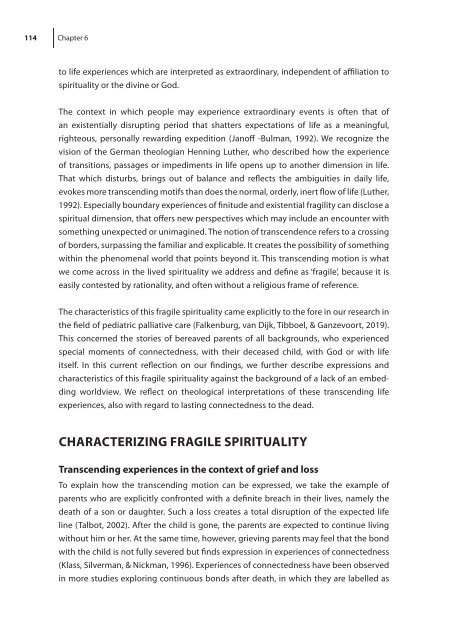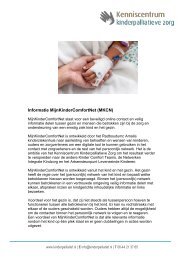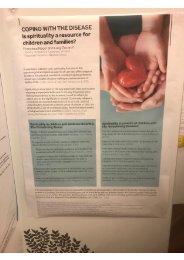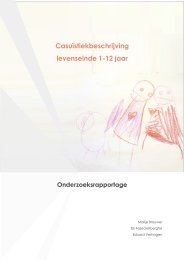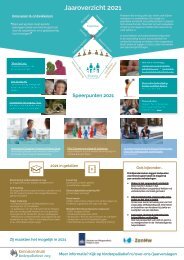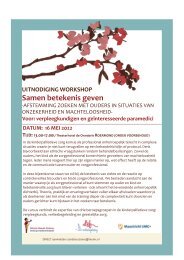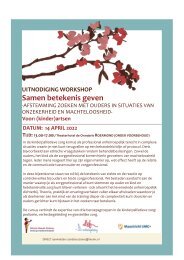Unveiling a fragile spirituality: Experiences of connectedness in pediatric palliative care
You also want an ePaper? Increase the reach of your titles
YUMPU automatically turns print PDFs into web optimized ePapers that Google loves.
114 Chapter 6<br />
to life experiences which are <strong>in</strong>terpreted as extraord<strong>in</strong>ary, <strong>in</strong>dependent <strong>of</strong> affiliation to<br />
<strong>spirituality</strong> or the div<strong>in</strong>e or God.<br />
The context <strong>in</strong> which people may experience extraord<strong>in</strong>ary events is <strong>of</strong>ten that <strong>of</strong><br />
an existentially disrupt<strong>in</strong>g period that shatters expectations <strong>of</strong> life as a mean<strong>in</strong>gful,<br />
righteous, personally reward<strong>in</strong>g expedition (Jan<strong>of</strong>f -Bulman, 1992). We recognize the<br />
vision <strong>of</strong> the German theologian Henn<strong>in</strong>g Luther, who described how the experience<br />
<strong>of</strong> transitions, passages or impediments <strong>in</strong> life opens up to another dimension <strong>in</strong> life.<br />
That which disturbs, br<strong>in</strong>gs out <strong>of</strong> balance and reflects the ambiguities <strong>in</strong> daily life,<br />
evokes more transcend<strong>in</strong>g motifs than does the normal, orderly, <strong>in</strong>ert flow <strong>of</strong> life (Luther,<br />
1992). Especially boundary experiences <strong>of</strong> f<strong>in</strong>itude and existential fragility can disclose a<br />
spiritual dimension, that <strong>of</strong>fers new perspectives which may <strong>in</strong>clude an encounter with<br />
someth<strong>in</strong>g unexpected or unimag<strong>in</strong>ed. The notion <strong>of</strong> transcendence refers to a cross<strong>in</strong>g<br />
<strong>of</strong> borders, surpass<strong>in</strong>g the familiar and explicable. It creates the possibility <strong>of</strong> someth<strong>in</strong>g<br />
with<strong>in</strong> the phenomenal world that po<strong>in</strong>ts beyond it. This transcend<strong>in</strong>g motion is what<br />
we come across <strong>in</strong> the lived <strong>spirituality</strong> we address and def<strong>in</strong>e as ‘<strong>fragile</strong>’, because it is<br />
easily contested by rationality, and <strong>of</strong>ten without a religious frame <strong>of</strong> reference.<br />
The characteristics <strong>of</strong> this <strong>fragile</strong> <strong>spirituality</strong> came explicitly to the fore <strong>in</strong> our research <strong>in</strong><br />
the field <strong>of</strong> <strong>pediatric</strong> <strong>palliative</strong> <strong>care</strong> (Falkenburg, van Dijk, Tibboel, & Ganzevoort, 2019).<br />
This concerned the stories <strong>of</strong> bereaved parents <strong>of</strong> all backgrounds, who experienced<br />
special moments <strong>of</strong> <strong>connectedness</strong>, with their deceased child, with God or with life<br />
itself. In this current reflection on our f<strong>in</strong>d<strong>in</strong>gs, we further describe expressions and<br />
characteristics <strong>of</strong> this <strong>fragile</strong> <strong>spirituality</strong> aga<strong>in</strong>st the background <strong>of</strong> a lack <strong>of</strong> an embedd<strong>in</strong>g<br />
worldview. We reflect on theological <strong>in</strong>terpretations <strong>of</strong> these transcend<strong>in</strong>g life<br />
experiences, also with regard to last<strong>in</strong>g <strong>connectedness</strong> to the dead.<br />
CHARACTERIZING FRAGILE SPIRITUALITY<br />
Transcend<strong>in</strong>g experiences <strong>in</strong> the context <strong>of</strong> grief and loss<br />
To expla<strong>in</strong> how the transcend<strong>in</strong>g motion can be expressed, we take the example <strong>of</strong><br />
parents who are explicitly confronted with a def<strong>in</strong>ite breach <strong>in</strong> their lives, namely the<br />
death <strong>of</strong> a son or daughter. Such a loss creates a total disruption <strong>of</strong> the expected life<br />
l<strong>in</strong>e (Talbot, 2002). After the child is gone, the parents are expected to cont<strong>in</strong>ue liv<strong>in</strong>g<br />
without him or her. At the same time, however, griev<strong>in</strong>g parents may feel that the bond<br />
with the child is not fully severed but f<strong>in</strong>ds expression <strong>in</strong> experiences <strong>of</strong> <strong>connectedness</strong><br />
(Klass, Silverman, & Nickman, 1996). <strong>Experiences</strong> <strong>of</strong> <strong>connectedness</strong> have been observed<br />
<strong>in</strong> more studies explor<strong>in</strong>g cont<strong>in</strong>uous bonds after death, <strong>in</strong> which they are labelled as


